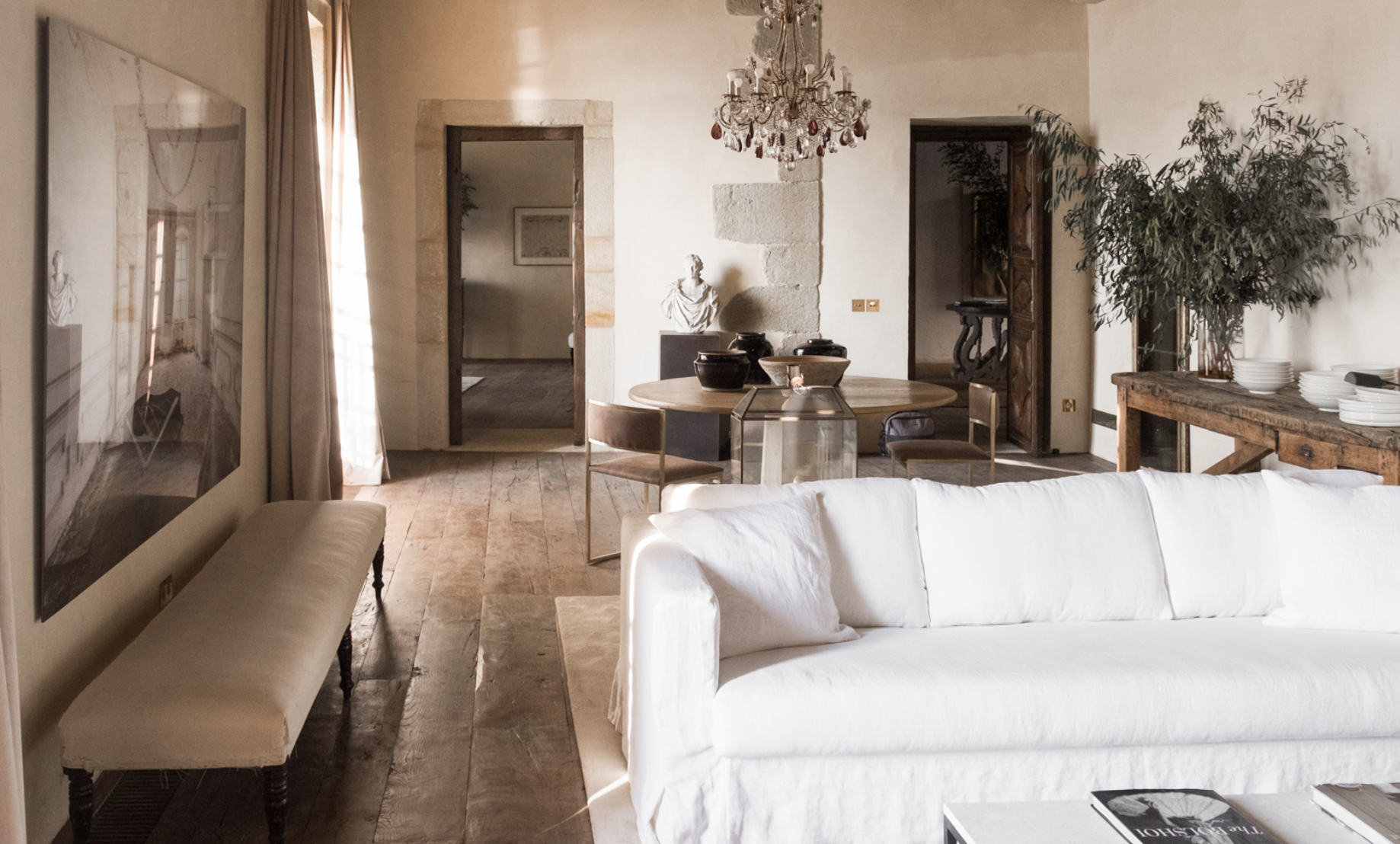As we emerge from lockdown, we reflect on how we’ll reinvent our homes — and what matters now. Our homes have been a refuge yet they are often filled with too many people (and their pets) doing things the spaces were never meant for, like school, work, and physical activity.
The 19th-century rural model; the home as the site of leisure and production has been reprised – although the activity may be happening in a cramped apartment now instead of an airy farmhouse says The New York Times in an article earlier this year.
“Partners and children have stayed put, which has been both a boon and corrosive to family life, depending on the family — or the day. Or maybe the home has been empty save for one human, and the place that was intended to be a launching pad or a respite from the energy of public life may have felt like solitary confinement. And that’s if you’re lucky.” After eighteen months confined to our homes, we look at our places and how our relationships with our homes have changed. Read more, ‘The New Comfort, What Does “Home” Mean To Us in 2021.’

Space has become democratized, and interstitial space can become primary space. Photo: @lasparelli
Our homes now operate 24/7. Before, they used to take a break from us during working hours. We are paying more attention to them, but we are also wearing them out. They are tired of us. We need to be gentler with them. Spaces usually dedicated to hospitality have been taken over by us, the hosts. The guest bedroom is now a study; the reception area, the gym. The line between office and home has been erased. Home is not where we receive people anymore. Read more, ‘Exploring the Home of Tomorrow: Top 10 Design Trends.’
We worry that this change will last longer than the others. Home may no longer be hospitable for some time.
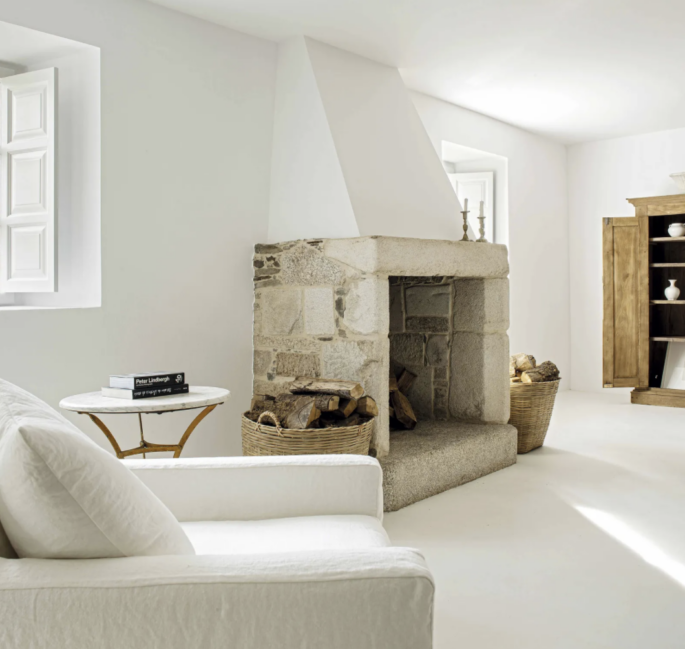
You want to know your home is secure, stable and you can touch everything from tactile walls to stone fireplaces and linen cushions. Photo: @lasparelli
The pandemic has been quite categorical about what types of households it deems safer than others: solitary living is the safest, then the nuclear family home. The extended family home is threatened. Grandparents are isolated within the larger household, or away from it. The multiple families or shared homes or apartment buildings have entered into new spatial contracts that govern more strictly the behaviour of the residents — not just what happens at home, but what happens outside. Read more, ‘Can You Design A Happy Home- It’s Easier Than It Looks.’
The more space you have, the easier it is. Change is coming. We are on the cusp of an impactful new era that is reshaping the way we live in better ways. Excitement and positivity comes in many forms.
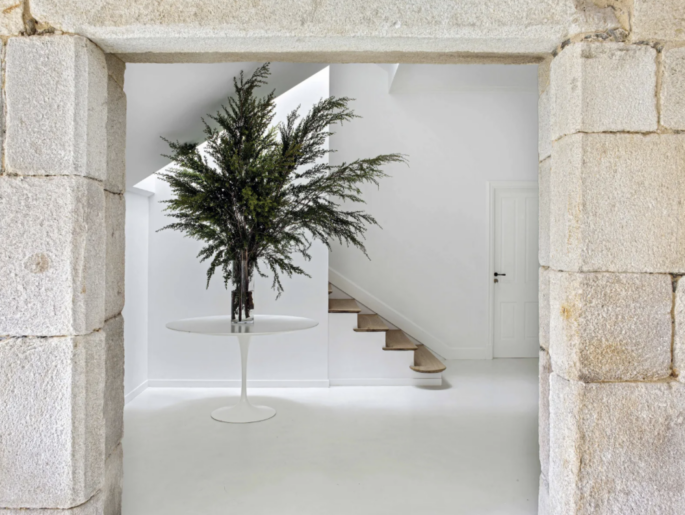
The pandemic has forced us to rethink how we use space. Space has become democratized. Interstitial space can become primary space. Photo: @lasparelli
In the wake of the pandemic, a growing consensus is emerging that the current system is failing people and the planet. This will be a time of transition, as old systems creak and shift, and a new order seeks to impose itself. Here are the changes and trends we see taking place:
A Soothing Interior with Seats that Embrace You
The world is constantly telling us: Don’t touch! Don’t hug!” So at home, we want to feel safe enough to touch our own things. We want to know our homes are secure, stable and we can touch everything. Comfort has become a high priority on the home front. With that in mind, we want the most sink-into-able chairs and sofas waiting to give us a big hug. Who among us wouldn’t welcome an embrace from a chair these days? The lack of hugging means you want to touch more. Whether it’s stroking a sofa, fabric or wallpaper, tactility is now more important than ever. Holding something, feeling it with your fingertips, has really been missed and the chance to do it in your own home, improves our moods. We’re looking at design as something that is very cushion-y and textural.We imagine that we’ll continue to see a softening in design — softer colours, rounded benchtops, curvier furniture, more texture, and sensuality. Read more, ‘The Six Surprising Tips to a Happy Home.’
People are increasingly gravitating to touchable textiles like velvet, mohair and soft bouclé.
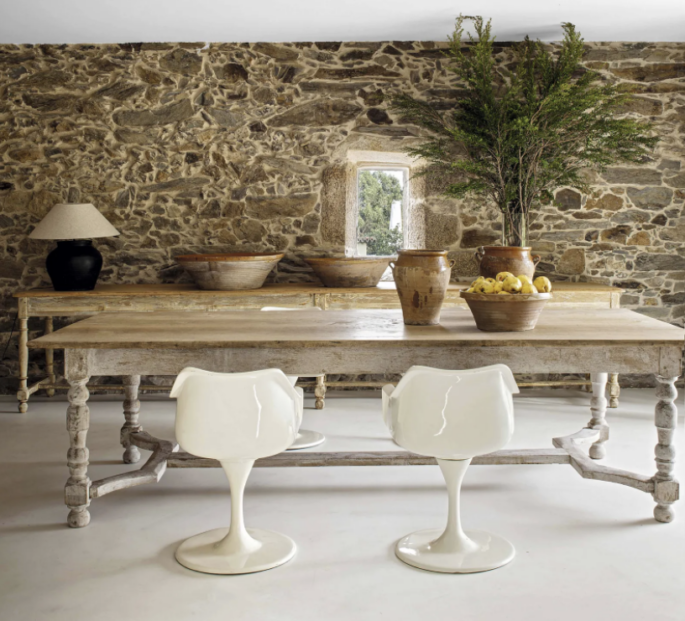
Soothing interiors: we’ll continue to see a sensuality in design — softer colours, rounded curvier furniture, more texture, and tactality.Photo: @lasparelli
A Need for Organisation
The stress caused by an open-plan layout crowded with desks and workspaces has also led to another trend: an increase in the need for storage spaces where we can quickly put away (or hide) the things that have been left lying around, so we can relax in a tidy space. It’s about looking for control in out-of-control times.
Thoughtful Storage Areas
Kitchen appliances in smaller apartments may swell in size after shrinking in recent decades. Refrigerators kept getting smaller that seemed acceptable when people were dining out regularly. Now we want bigger models that can easily store one week’s supplies at a time.
Enhanced Technology
A heightened awareness of how people pick up viruses from the surfaces they touch is leading to more widespread adoption of smart-home technology. Maybe it’s going to become a new standard where your lights will go on automatically and your door will unlock when you come home, with such technology readily available. Or you’ll be able to talk to the elevator, instead of pressing buttons.
Indoor ventilation systems are also getting upgraded. There will be a great improvement in mechanical systems, air-conditioning and heating that will perhaps provide more fresh air so you get more air turnover in an apartment. Filters will be improved, and even ways of perhaps killing bacteria and viruses will be improved, so that people feel really safe at home, particularly in apartments. All these systems are going to be brought up to a new level of sophistication.
Access to the Outdoors
If the experience of sheltering in a pandemic has taught us anything, it is that being in nature drops our cortisol levels, makes us calmer, reduces anxiety and improves our mood, After spending so much time indoors, having access to fresh air and nature at home has become a priority. One way to provide a closer connection to nature, is with more balconies and terraces. In cities where every square metre counts it can be achieved with French doors in a living room and a Juliet balcony. In a way, this helps make the whole living room, or whole dining room, can feel like an outside loggia. For apartments in newer buildings that sometimes lack fresh air, the simplest solution is a return to large, operable windows and designs for cross ventilation to encourage breezes. Fresh air is just so important for wellness.
Read more, ‘How Coronavirus Will Change Our Homes In The Next Decade.’

The pandemic has made us realise we all need an oasis at home to call our own, no matter how small it is. Photo: Tessa Neustadt, tessaneustadt.com
Turn Your Home Into the Best Classroom
A desk of one’s own isn’t a necessity for success at school — after all, many of us grew up doing our homework at the kitchen table. The most important thing is to have one consistent spot, even if it’s in a multipurpose room like a dining room, where children can follow a learn-at-home routine. Carve out space for schoolwork based on your child’s age and learning style.
One of the best ways parents can support home-schooling is to provide a dedicated space for your child to focus on their studies amid all the distractions.
The younger your child is, the more you’ll want that study space to be in a central location. Some older children also work best in environments with plenty of people around them, so consider sharing your work-from-home space. If you can find room in your home office, a separate desk for your child that’s free of your work items is ideal. Older children may want more privacy, especially if they’re frequently in video classes and your presence is distracting. Read more, ‘The Home Lockdown Guide: How To Prepare For Quarantine.’
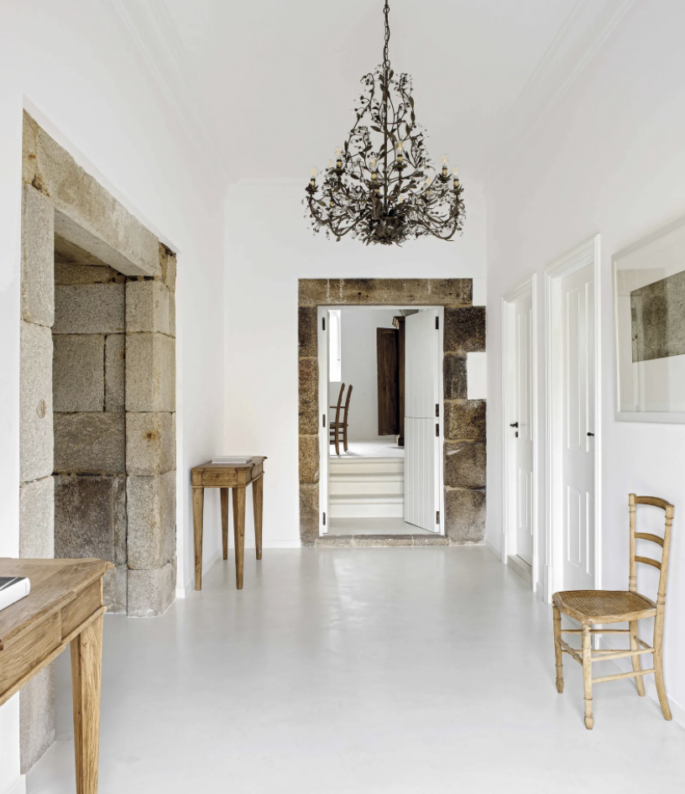
Homes have turned into sanctuaries, spas and restaurants: living spaces that are havens from the outside world. Photo: @lasparelli
Homes Have Turned into Sanctuaries, Spas, and Restaurants
As the pandemic has worn on, people have begun thinking past mere survival towards how they could turn their living spaces into sanctuaries rather than bunkers. Our homes aren’t just shelters from a deadly pandemic but need to be galleries, restaurants, and spas too. Read more, ‘How Previous Pandemics Impacted Home Design.’

Make your bathroom into your own personal spa no matter how big or small. Light a candle, draw a bath, and relax. Photo: Lesley Unruh, unruhphoto.com
Bedroom Size Doesn’t Matter
As more of us use our homes to work, have children stay at home for longer, or rent our homes through online platforms to others, what we ask of our homes is changing. The new adaptability requires us to think of our homes less in terms of size and dimensions, and more in terms of the multiple uses and functions that each space can host.
Our homes must be designed so they can adapt to meet our needs now and in the future and the size of our biggest or smallest bedrooms is not a predictor of home happiness.

Home and relationship to them has changed. Bedrooms no longer need to be huge. Photo: @lasparelli
Display Cabinets
Whether it’s because our living spaces have become Zoom backdrops or because our obsession with houseplants has continued to bloom, glass display cabinets are all the rage. Ikea’s metal-framed “Rudsta” was released in February 2021 and was soon all over Instagram, where users dotted their shelves with plants, ceramics, candles, and barware. Similar models by other brands have been a reliable presence on the pages of design magazines and websites.
If these are a bit too indoor-greenhouse for your taste, small-drawer “apothecary” cabinets are also back — a clever way to tidy away pandemic clutter.
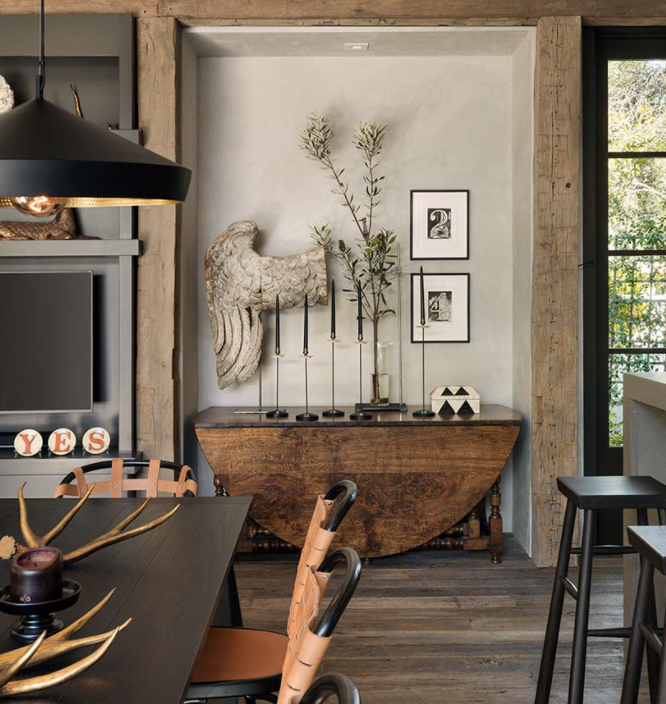
Use every opportunity that presents itself to get clever. The pandemic has forced us to rethink how we use space. Photo: Jose M Aldora, josemanuelalorda.com
For Tranquility, Connect Design to Nature
Given the hazards of the outside world, many of us have tried to bring a touch of nature into our homes — a trend that looks set to continue even when lockdowns started to ease.
Those lucky enough to have gardens have splurged on plants, bulbs, and birdbaths; even people without outdoor space experimented with assembling indoor herb gardens and more houseplants.
So-called biophilic design is a major trend in architecture and has filtered down into homewares too, with green, blue, and sand-coloured paint palettes becoming popular and a renewed interest in wooden surfaces and finishes. Tapping the quiet power of pale blue – with a paint colour such as Whispering Spring from Benjamin Moore looks great paired with timbers like walnut or oak and leather. Read more, ‘The Dream Home Has Changed.’
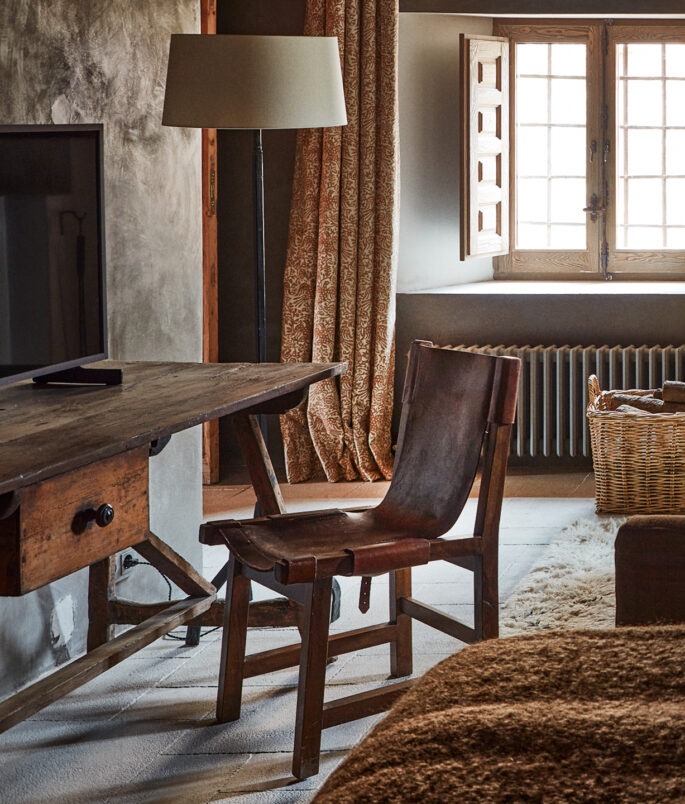
Handworked natural materials and finishes paired with sculptural silhouettes are the building blocks of the firm’s refined organic chic — the work of the hotel’s young Madrid-based designers, Gonzalo Machado and Mafalda Muñoz, of Casa Muñoz. Photo: 1stdibs.com
Escape Into Cottagecore, A Calming Ethos
The fad for countryside style: florals to wicker baskets and tea served in antique china — became popular on TikTok and Instagram in 2019 and was recently described in the Financial Times: “Everything during Covid is about seeking comfort, self-care, escapism. Think no to sleek marble fixtures and grey colour palettes, yes to dried flowers, gingham checks, handcrafted furniture, quilts, and candles.”
After a decade dominated by whitewashed walls, monster plants, and midcentury reproduction furniture, the pandemic has led to a desire for something wilder and more pastoral to take root.
Even limewash is back: used to decorate and protect plaster and stone for millennia, this limestone-based paint has become omnipresent on interior design Instagram. Harper’s Bazaar has noted its ecological and non-toxic credentials and points out that with the right primer you don’t even need to have ancient plaster walls to get an antique, weather-worn look.

We’re looking at design as something that’s very textural. The lack of hugging due to the pandemic, means you want tactile, touch-y surfaces in the safety of your own home.Photo: @lasparelli
How to Escape Without Leaving Your Home
The pandemic has made us realise we all need an oasis at home to call our own, no matter how small it is, according to The New York Times in a recent article. “The value of creating a private oasis is mental refreshment. It’s an opportunity for reflection. So if you think about escaping as a way to give your mind some time to reset, rather than seeking out a new physical space, you can find respite without going outside” — even if it’s a chair turned just so – or the empty floor space between bedroom curtains can be turned into a little desk area. Maybe an entry, a hall, or the nook under the stairs invites a seat. It’s all a matter of personal preference, and only a few principles generally apply. It’s also something that can be done affordably. Read more, ‘We Can’t Go Back to Normal- How Coronavirus Will Change Home Design.’
All you need is the tiniest corner. Set up tables outside, like those side-street cafe tables, a home sanctuary can be set up and taken down ad hoc.
If you have modular furniture, break from the expected arrangements. A modular sectional sofa can be separated into individual chairs, with the arms in the centre instead of at the ends, creating more personal space. A modular dining table can be separated and pushed to the sides of the room after meals to make a one-person escape pod.
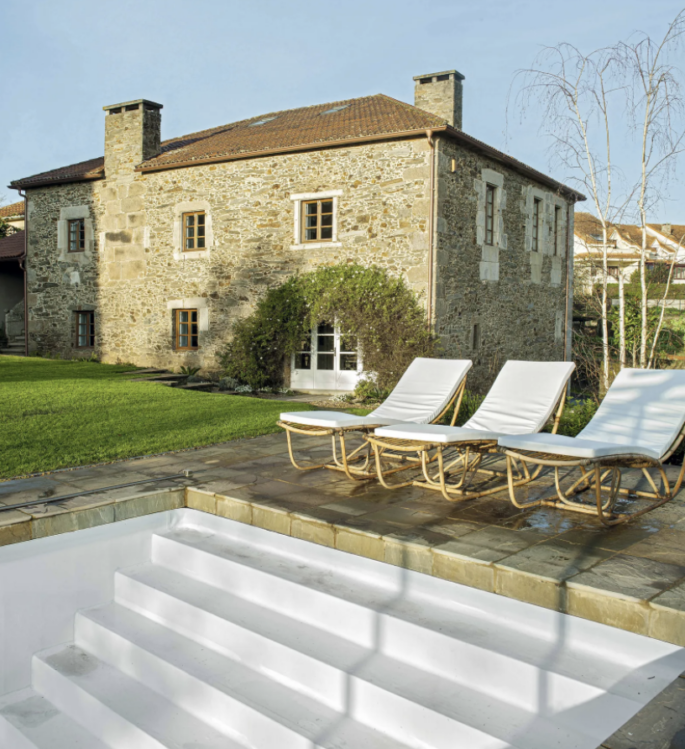
Set up bamboo furniture outside, a home sanctuary can be set up and taken down ad hoc. Break from expected arrangements. Photo: @lasparelli
If there’s enough headroom under your stairs, turn it into a phone nook away from flapping ears. Seeing greenery — whether out the window, or a plant on a nearby table — can also channel feelings of relaxation and escape. When you intentionally gaze at a plant of your own choosing for three minutes whenever feeling stressed, you’ll instantly feel better. If you don’t have a green thumb, try succulents which are low-maintenance but visually appealing.
If possible, set up your escape area near a window. It gives you a visual focus length beyond your small space.
In other words, you can pretend your little oasis is bigger than it really is while relaxing your eyes and your mind. Use every opportunity that presents itself to get clever. The pandemic has forced us to rethink how we use space. Space has become democratized, and interstitial space can become primary space.
Parts of this article are edited excerpts that appeared in The New York Times.

